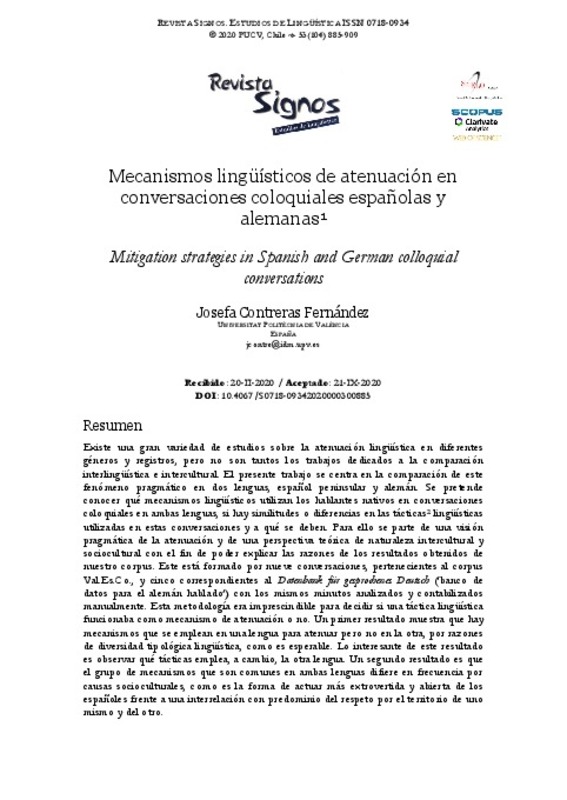|
Resumen:
|
[EN] There is a great variety of studies on linguistic mitigation in different genres and
registers, but there are not so many research into interlinguistic and intercultural
comparison. This paper focuses on the comparison ...[+]
[EN] There is a great variety of studies on linguistic mitigation in different genres and
registers, but there are not so many research into interlinguistic and intercultural
comparison. This paper focuses on the comparison of this pragmatic phenomenon in
two languages, Peninsular Spanish and German. The purpose is to find out what
mechanisms native speakers use in colloquial conversations in both languages, if there
are similarities or differences in the mechanisms used in these conversations and what
they are due to. This is based on a pragmatic vision of mitigation and on an
intercultural and sociocultural theoretical perspective, in order to explain the reasons
for the results obtained. Our corpus consists of nine conversations belonging to the
Val.Es.Co. corpus and five corresponding to the Datenbank für gesprochenes Deutsch (`data
bank for spoken German¿) with the same minutes analyzed and manually counted. This
methodology was essential to decide whether a mechanism worked as an mitigation
mechanism or not. A first result shows, as expected, that there are mechanisms that are
used in one language to mitigate but not in the other, for reasons of linguistic
typological diversity. This finding is interesting because it reveals which mechanisms the
other language uses instead. A second result is that the group of mechanisms that are
common in both languages differs in frequency due to socio-cultural causes, such as the
more outgoing and open nature of the Spanish speakers in contrast to the interactions
which are more respectful of one's own territory and of the other, characteristic of the
German culture
[-]
[ES] Existe una gran variedad de estudios sobre la atenuación lingüística en diferentes géneros y registros, pero no son tantos los trabajos dedicados a la comparación interlingüística e intercultural. El presente trabajo ...[+]
[ES] Existe una gran variedad de estudios sobre la atenuación lingüística en diferentes géneros y registros, pero no son tantos los trabajos dedicados a la comparación interlingüística e intercultural. El presente trabajo se centra en la comparación de este fenómeno pragmático en dos lenguas, español peninsular y alemán. Se pretende conocer qué mecanismos lingüísticos utilizan los hablantes nativos en conversaciones coloquiales en ambas lenguas, si hay similitudes o diferencias en las tácticas2 lingüísticas utilizadas en estas conversaciones y a qué se deben. Para ello se parte de una visión pragmática de la atenuación y de una perspectiva teórica de naturaleza intercultural y sociocultural con el fin de poder explicar las razones de los resultados obtenidos de nuestro corpus. Este está formado por nueve conversaciones, pertenecientes al corpus Val.Es.Co., y cinco correspondientes al Datenbank für gesprochenes Deutsch (`banco de datos para el alemán hablado¿) con los mismos minutos analizados y contabilizados manualmente. Esta metodología era imprescindible para decidir si una táctica lingüística funcionaba como mecanismo de atenuación o no. Un primer resultado muestra que hay mecanismos que se emplean en una lengua para atenuar pero no en la otra, por razones de diversidad tipológica lingüística, como es esperable. Lo interesante de este resultado es observar qué tácticas emplea, a cambio, la otra lengua. Un segundo resultado es que el grupo de mecanismos que son comunes en ambas lenguas difiere en frecuencia por causas socioculturales, como es la forma de actuar más extrovertida y abierta de los españoles frente a una interrelación con predominio del respeto por el territorio de uno mismo y del otro.
[-]
|









